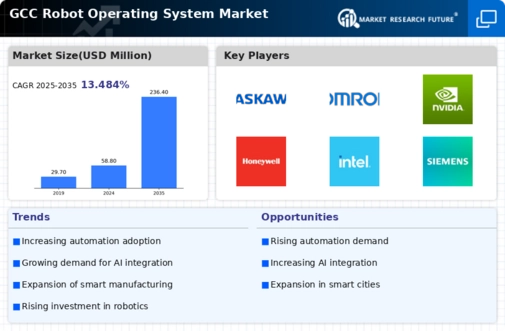The competitive landscape of the GCC Robot Operating System Market is evolving rapidly, driven by advancements in automation and artificial intelligence across various industries. As key players look to enhance operational efficiency, robotics continues to play a pivotal role. The market is characterized by the presence of both established firms and emerging companies competing for market share. Factors such as technological innovations, industry partnerships, and increased investments in automation technologies are influencing market dynamics. The GCC region, with its increasing focus on diversifying economies and elevating manufacturing capabilities, is seeing a surge in demand for robotic solutions.
This competitive environment creates opportunities as well as challenges for businesses operating in this arena, as they position themselves to meet the changing demands of their customers.
Yaskawa has developed a strong foothold in the GCC Robot Operating System Market by leveraging its reputation for high-quality robotic solutions and automation equipment. The company is recognized for its commitment to innovation and customer satisfaction, which has allowed it to establish long-term relationships with local manufacturers and distributors in the region. Yaskawa's strengths include its extensive product range, which encompasses industrial robots for applications such as welding, assembly, and packaging. Furthermore, Yaskawa has been proactive in adapting its offerings to cater to the specific needs of the GCC market, contributing to enhanced productivity and efficiency for customers.
Their implementation of training and support services further bolsters their presence, making Yaskawa a preferred choice among businesses looking to adopt robotic solutions in various sectors.
Omron has also asserted a significant presence in the GCC Robot Operating System Market, focusing on providing integrated automation solutions that include robotics, sensors, and control devices. The company emphasizes its strengths in manufacturing technologies, particularly in food processing, automotive, and electronics sectors. Omron's key products and services in the GCC include collaborative robots, which are designed to work alongside human operators, enhancing workplace safety and efficiency. The company has engaged in strategic partnerships and collaborations, positioning itself advantageously to leverage regional opportunities.
Omron has also made efforts to expand its operations through mergers and acquisitions, improving its access to local markets and bolstering its technological expertise. These initiatives not only enhance their product offerings but also solidify Omron's role as a leading player in the GCC Robot Operating System Market amidst a competitive landscape.
























Leave a Comment